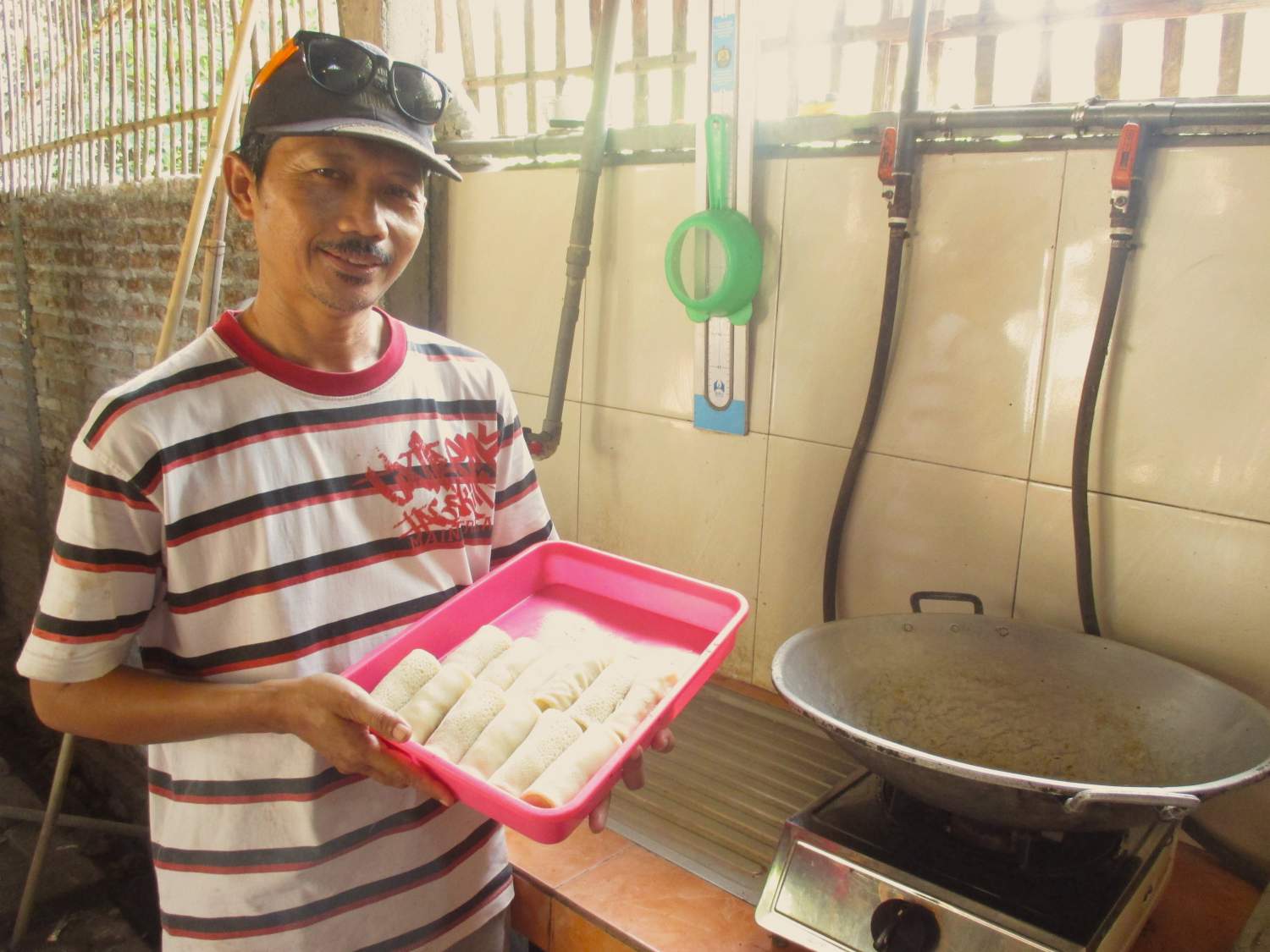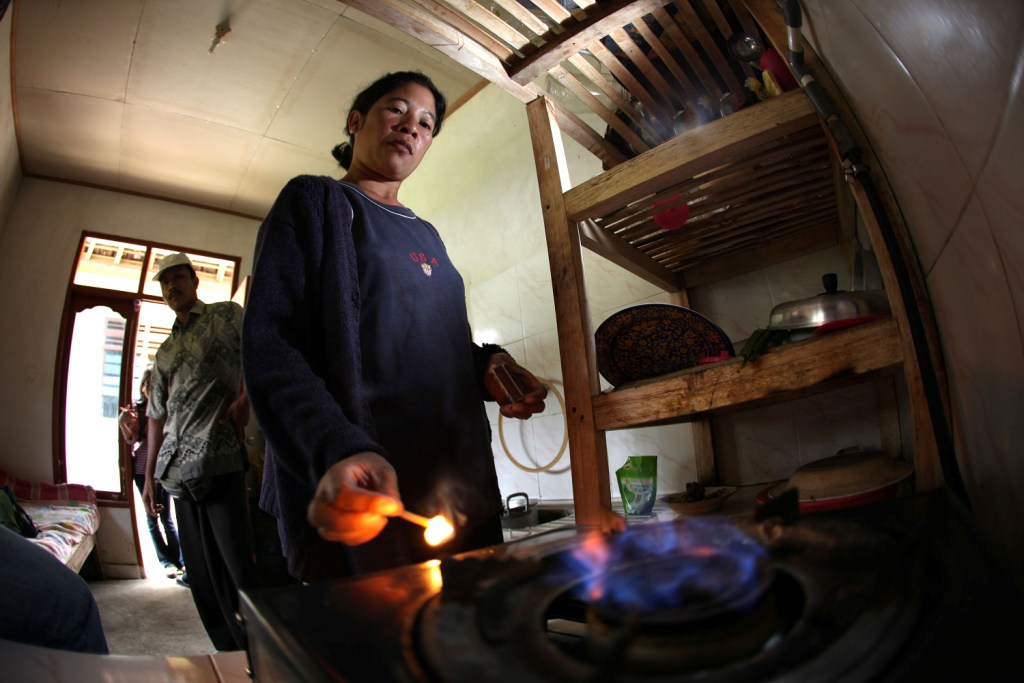Joshua Parfitt
‘You can get poo and no eggs, but you can’t have eggs without poo,’ explains Arum Ahmad Aris, a quail farmer from Blitar, East Java. ‘My birds are pooing money. I’ve calculated I’m making five rupiah per dropping.’
Arum had a biogas digester built in July 2015. Every day he puts 20 kilograms of quail droppings with water into the digester, in return receiving methane gas piped straight to a special biogas stove. He claims this gas has significantly cut his usage of liquid petroleum gas (LPG), which his wife utilises to cook for the family and run a home catering business. The savings add up to over Rp.6 million (A$596) per year or roughly four months on a regional minimum wage.
In a strong agrarian society such as Indonesia, biogas holds the key to many treasures; a domestic-scale digester, such as Arum’s, has the potential to turn agricultural waste into a renewable source of cooking gas. The Jakarta government is grappling with large fossil fuel subsidies, a portion of which is applied to three-kilogram cylinders of LPG. Biogas can replace this non-renewable fuel, thereby reducing subsidies without raising consumer expenses.
LPG subsidisation
In 2007 the Indonesian government began a kerosene-to-LPG conversion program. The objectives were twofold: to cut large subsidies for kerosene and to give low-income households and small businesses access to a cleaner source of fuel. According to a report by the non-governmental International Institute of Sustainable Development (IISD), the project was rolled out to 42 million households nationwide. Each recipient was given a free starter kit consisting of a three-kilogram cylinder, a gas stove and accessories.
The program was hugely successful. Data from the Pertamina website – the state-owned oil and gas company licensed to sell LPG – shows that to date over 57 million starter kits have been distributed across the country. The use of kerosene as a cooking fuel has been reduced from 9.85 million kilolitres, when the conversion program began, to just 0.85 million kilolitres in 2015.
Since 2007, savings in kerosene subsidies have been calculated at Rp.197 trillion. LPG subsidies, on the other hand, are rising each year. In the 2016 national budget the subsidy is expected to reach Rp.31 trillion. Fossil fuel subsidies have been a major issue for the Indonesian government. In 2013 they reached about 20 per cent of state expenditure. Though the LPG subsidy began as a cost-saving initiative, it has recently come under scrutiny.
One of the reasons is that, like kerosene, the subsidies are becoming financially burdensome. Earlier this year the government made plans to cut the LPG subsidy by Rp.1000 per kilogram, but they were not implemented thanks to a drop in global gas prices. Indonesia imports over 60 per cent of its LPG, creating fears that subsidisation will put a strain on government expenditure when prices rise again.
Another issue is that LPG is overwhelmingly used by middle-to-high income sections of society. A separate report by the IISD found that only 3.8 per cent of LPG subsidies reached the lowest income groups, whilst 53.8 per cent reached the highest. The three-kilogram cylinders are supposed to be issued only to low-income households and small businesses, but in practice anyone can purchase one of the canisters.
The government is seeking solutions to the issue. One suggestion is to create natural gas infrastructure in cities, so citizens do not need to buy subsidised LPG. Pilot programs are also being considered such as monitoring businesses, hotels and higher-income consumers to ensure they purchase only non-subsidised gas, which comes in conspicuously different tanks.
The case for biogas
A Balinese woman lights up the biogas stove, 2012 (Credit: Biogas Rumah)
Wasis Sasmito is the East Java provincial coordinator for the Indonesian biogas program, Biogas Rumah (Domestic Biogas), or BIRU. During a telephone interview, Wasis expressed the hope that with biogas rural Indonesians could ‘help the government to reduce the burden of subsidies’. The biogas digesters produced by BIRU have a minimum lifetime of 25 years, meaning that after installation there would be no extra costs for many years.
Close to 18,000 biogas digesters have been built under the BIRU program. Wasis estimates that this means around 20,000 rural households no longer need LPG. According to his calculations, a family home in Indonesia consumes at least two three-kilogram cylinders of LPG per month. With government subsidies currently at Rp.5750 per kilogram of LPG, the BIRU program is saving the government some Rp.7.2 billion per year.
Another biogas supporter is Royani Marhan, owner of the social non-government foundation Tayseer. As part of its mission to improve local independence, Tayseer has been facilitating biogas construction and entrepreneurship. According to Royani, biogas can reduce household expenditure and even bring in a profit.
Tayseer’s field reports show that biogas has financially supported recipients in significant ways. Alongside a reduction in LPG fuel for daily cooking requirements, saving roughly Rp. 40,000 per month, excess gas has been used to start up or supplement home industries. The fermented solid by-product known as bio-slurry can be used as a fertiliser or compost. Royani says his model client is the owner of an orphanage in Rembang, who uses the bio-slurry to grow mushrooms and worms, and then sells the worm humus as compost.
Royani says that the self-sufficiency in energy and food production which biogas provides will help to protect Indonesian consumers from changes in the global market. The technology should also be directed exclusively to rural low-income consumers, since they are the communities who tend to keep animals. Animal waste is all that is needed to generate gas and two cows can provide sufficient manure for a household’s cooking requirements.
I interviewed Royani whilst driving out along the north coast of Java to visit the Rembang orphanage. A barge floated out at sea loaded with coal from Kalimantan. ‘This island was once known as the most fertile in the world,’ he says, ‘now pollution and waste are our biggest issues. Nature can’t be forced, we have to be clever in following its patterns.’
Renewable energy is often understood solely from an environmental perspective. Indonesia shows that local organisations, such as BIRU, generate financial benefits that reach the highest levels of government. Looking from the sea to the south, Royani pointed to the green hills of Java: ‘It would be even more beautiful if our farmers began using biogas,’ he said.
Joshua Parfitt (mail@joshuaparfitt.com) resides in Yogyakarta. He is a freelance journalist with interests in the environment and renewable energy.

